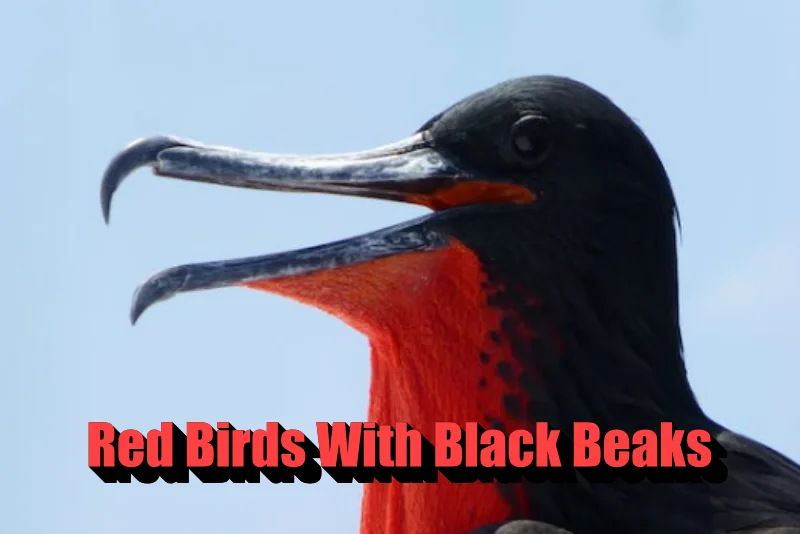It’s common to see entirely red or black birds in your neighborhood, but have you ever wondered about their beaks? If so, this article is for you. Today, I’ve compiled a list of 10 red birds with black beaks. And if you haven’t, you’re in for a treat. This article will introduce you to the 10 most magnificent red birds with black beaks.
So, without further ado, let’s dive right in.
10 Magnificent Red Birds With Black Beaks
1) Black-headed Gonolek
| Scientific Name | Laniarius erythrogaster |
| Size | 20 to 25 centimeters |
| Geographic Location | Eastern and Central Africa |
| Identification | It has a bold black head and eye-catching red on its belly and head |
A striking and distinctively colored bird in the Malaconotidae family. Its bold black and red coloration makes it stand out.
In the presence of human habitats, it is not shy about showing its true colors and majestic demeanor.
When it’s time to find a companion, the male sings a melodious, bell-like tune, and the female responds with a contrasting, grating response, creating a beautiful and harmonious medley.
The black-headed gonolek prefers to skulk in the undergrowth of thick woodlands and lush scrubs.
2) Crimson-breasted shrike
| Scientific Name | Laniarius atrococcineus |
| Size | 22 centimeters |
| Geographic Location | South Africa and Northern Cape |
| Identification | Easily identified by its black upper body and white wings with reddish underparts. |
Both males and females have striking scarlet underparts and black upper bodies, suggesting no specific sexual dimorphism being observed in crimson-breasted shrikes.
These birds are known for their lively and distinct melodious whistles.
In South West Africa, the crimson-breasted shrike’s colors reminded people of their homeland flag, so it was affectionately called the “Reichsvogel” or “Empire bird.”
3) Rosy Thrush-tanager
| Scientific Name | Rhodinocichla rosea |
| Size | 20 centimeters |
| Geographic Location | Colombia, Costa Rica, Mexico, Panama, and Venezuela |
| Identification | The male has a pink streak in front of the eye, magenta underparts, and a dark upper body. |
The rosy thrush-tanager, also known as the rose-breasted thrush-tanager, showcases sexual dimorphism in terms of its appearance.
The males have a pink streak in front of the eye and magenta underparts, while the females have a deep ochre-toned underpart.
These birds are known for their shy and furtive nature. They often hop around in low undergrowth or dig through leaf litter with their distinctive beaks.
It’s the only tanager known to sing in duets, with two birds alternating and producing a beautiful succession of clear notes.
4) Crimson-breasted finch
| Scientific Name | Rhodospingus cruentus |
| Size | 12-13 centimeters |
| Geographic Location | Western Ecuador, northwestern Peru, and southwestern Colombia |
| Identification | Glossy-black and red underparts |
The male crimson-breasted finch has glossy black and red underparts, while the female has a more subtle, tan-colored body with a buffy-tinged breast.
The males not only have red underparts but also a red crown.
The scientific name, Rhodospingus cruentus, is a combination of “rhodon” meaning “rose” in Ancient Greek, reflecting its crimson color, and “spingos” meaning “finch.”
These finches are known for their preference for woodland and scrub in western Ecuador, northwestern Peru, and extreme southwestern Colombia.
5) Crimson-backed Tanager
| Scientific Name | Ramphocelus dimidiatus |
| Size | 18 centimeters |
| Geographic Location | Northern and western Colombia, the Maracaibo Basin in Venezuela, and Panama |
| Identification | Adult males have maroon-red heads and chests. |
The crimson-backed tanager showcases a certain level of sexual dimorphism in terms of its appearance.
While the adult males have maroon-red heads and chests, a silver sheen on their lower mandibles, and black wings and tails, the females have dull blackish underparts.
This bird was first described by the French ornithologist and collector Frédéric de Lafresnaye in 1837.
It is usually seen in subtropical or tropical wetlands or moist lowland forests.
6) Pesquet’s parrot
| Scientific Name | Psittrichas fulgidus |
| Size | 46 centimeters |
| Geographic Location | Endemic to New Guinea |
| Identification | It has a unique black plumage and a red belly. |
Pesquet’s parrot is often nicknamed the “Dracula parrot” because of its unique appearance.
The adult male Pesquet’s parrot has a red spot behind its eye, making it easier for bird enthusiasts to differentiate between the two sexes.
They have shown a great inclination towards a fruit-based diet, especially figs.
Due to overhunting for their feathers and habitat loss, they are considered “vulnerable” on the IUCN Red List.
7) Maroon Oriole
| Scientific Name | Oriolus traillii |
| Size | NA |
| Geographic Location | Southeast Asia |
| Identification | The males have a glossy crimson-maroon body, black head, neck, and wings, and a chestnut-maroon tail. |
The maroon oriole is known for its distinct maroon and black plumage, with adult males having a rich crimson-maroon body and black head, neck, and wings.
Their coloration varies slightly based on location, with birds in the Indian Subcontinent displaying somewhat duller colors and those in Southeast Asia having brighter, more reddish tones.
These birds build their nests using natural materials like bast fiber, held together with cobwebs.
8) White-capped Redstart
| Scientific Name | Phoenicurus leucocephalus |
| Size | Around 19 centimeters |
| Geographic Location | Native to the Indian Subcontinent, Southeast Asia, China, and some parts of Central Asia. |
| Identification | Black body, red underparts, and a white crown on their heads |
Both male and female white-capped redstarts have a sleek black body with vibrant red underparts adorned with a distinctive white crown on their heads.
The males however have a slightly larger white area on the top of their heads and may sport brown or red spots beneath their wings.
The white-capped redstart used to be in its unique genus called Chaimarrornis, but it was later reclassified into the Phoenicurus genus based on a genetic study in 2010.
You’ll often find these birds in temperate forests, where they gracefully blend in with their surroundings.
9) Black-faced firefinch
| Scientific Name | Lagonosticta larvata |
| Size | 10–11 centimeters |
| Geographic Location | Found in numerous African countries |
| Identification | Females have gray-brown bodies with reddish undertones |
The Black-faced firefinches showcase sexual dimorphism in terms of their appearance.
Males have striking black faces and can vary in the color of their underparts from pale gray to rosy red. While the females are more subtle, with a gray-brown body and hints of reddish tones underneath.
They adapt to various habitats like woodlands, grasslands, and thickets, often staying close to water sources.
They communicate using soft and gentle whistles.
10) Scarlet flycatcher
| Scientific Name | Pyrocephalus rubinus |
| Size | 13-14 centimeters |
| Geographic Location | Native to southeastern South America |
| Identification | It has a distinct pointy tail and wings |
The scarlet flycatcher looks a lot like its sibling, the vermilion flycatcher, but if you carefully notice, it has slightly pointier wings and a distinct voice.
Some bird experts consider the scarlet flycatcher its own species, while others think of it as a subspecies of the vermilion flycatcher.
You can find them in a range of South American countries, from southeastern Bolivia and Brazil to Paraguay, Argentina, and Uruguay.
Conclusion
This concludes another article in our ongoing series of unraveling nature, one article at a time. Keep an eye out for these birds, and be sure to share your newfound knowledge with your friends. Stay tuned for more fun and informative articles.
References
- https://ebird.org/home
- https://en.wikipedia.org/wiki/Main_Page
Also Read:

Hi everyone, my name is Shawna, and I’ve always been fascinated by the fascinating diversity of flora and fauna that our nature has in it. I am currently studying biotechnology and am particularly interested in animal biotechnology, delving into the intricate processes that define their true nature and uniqueness.

